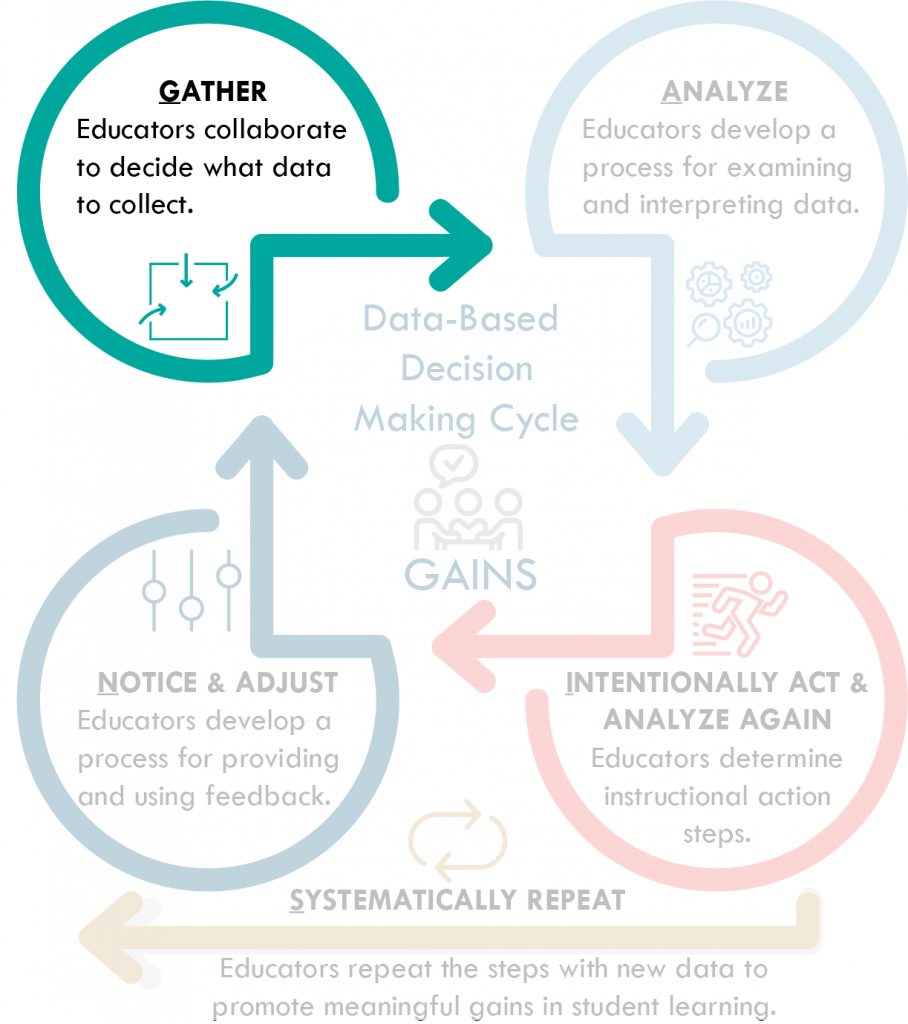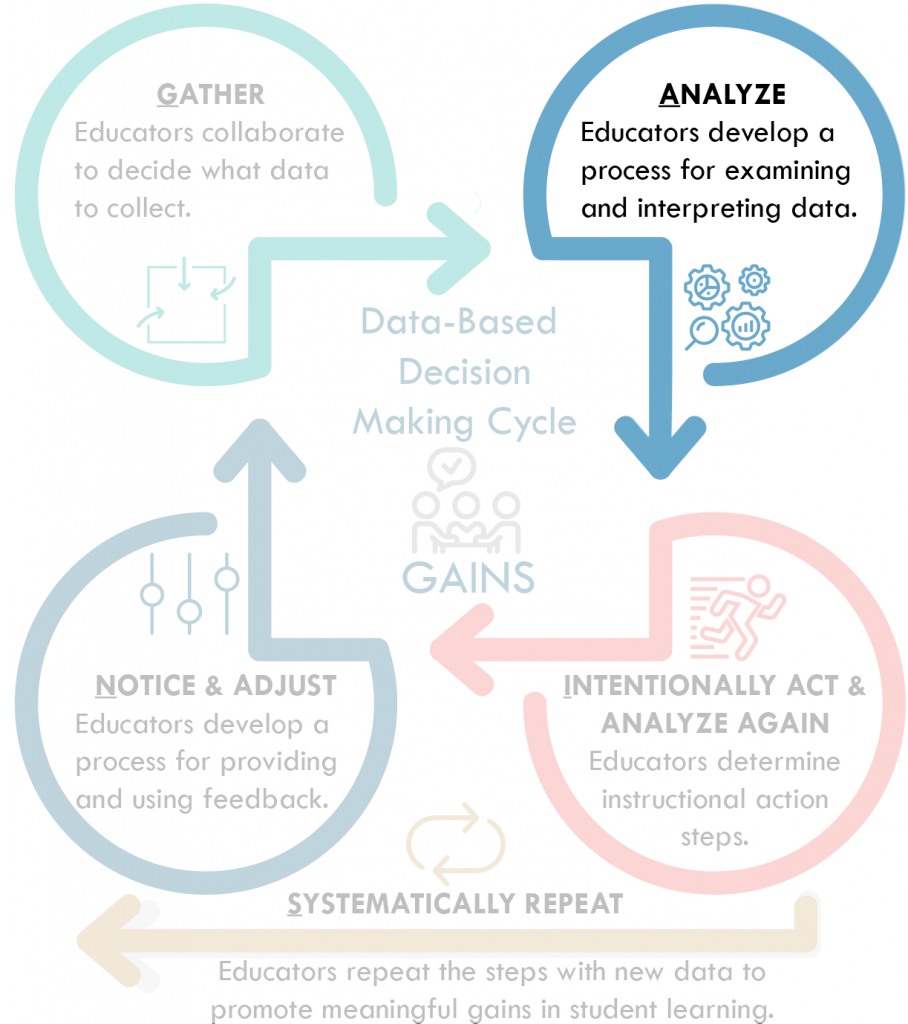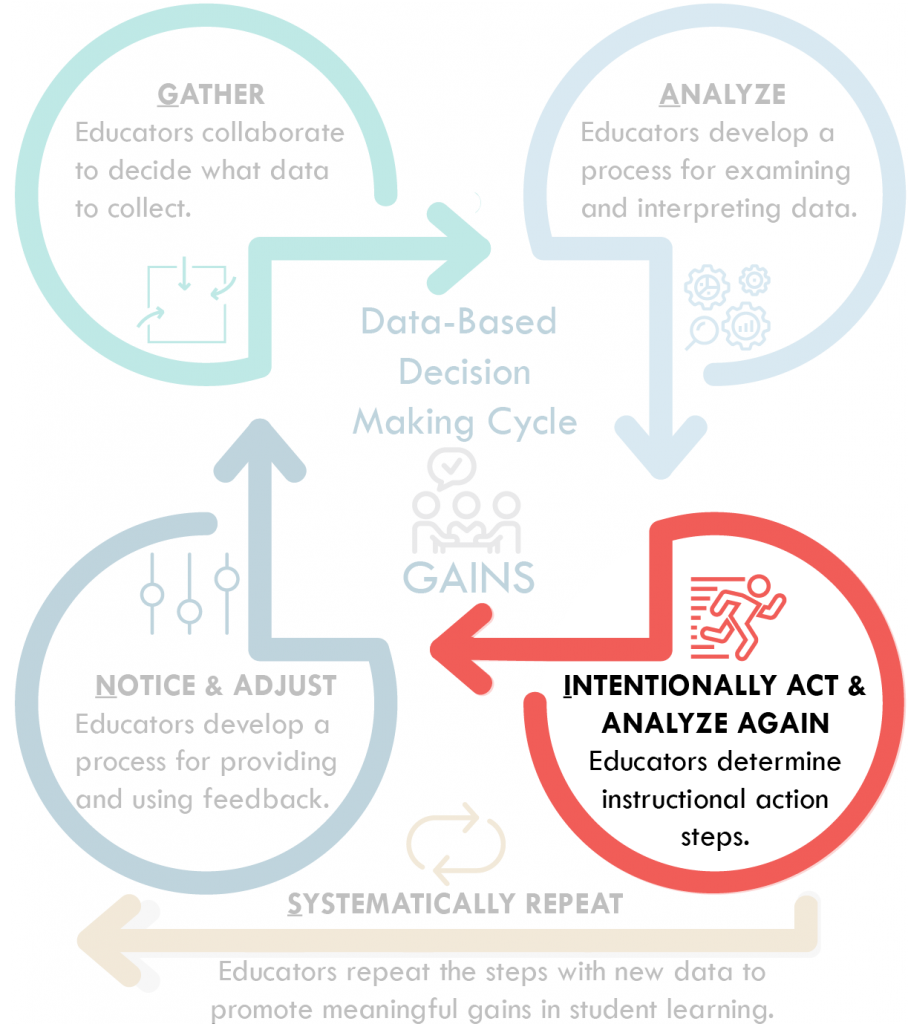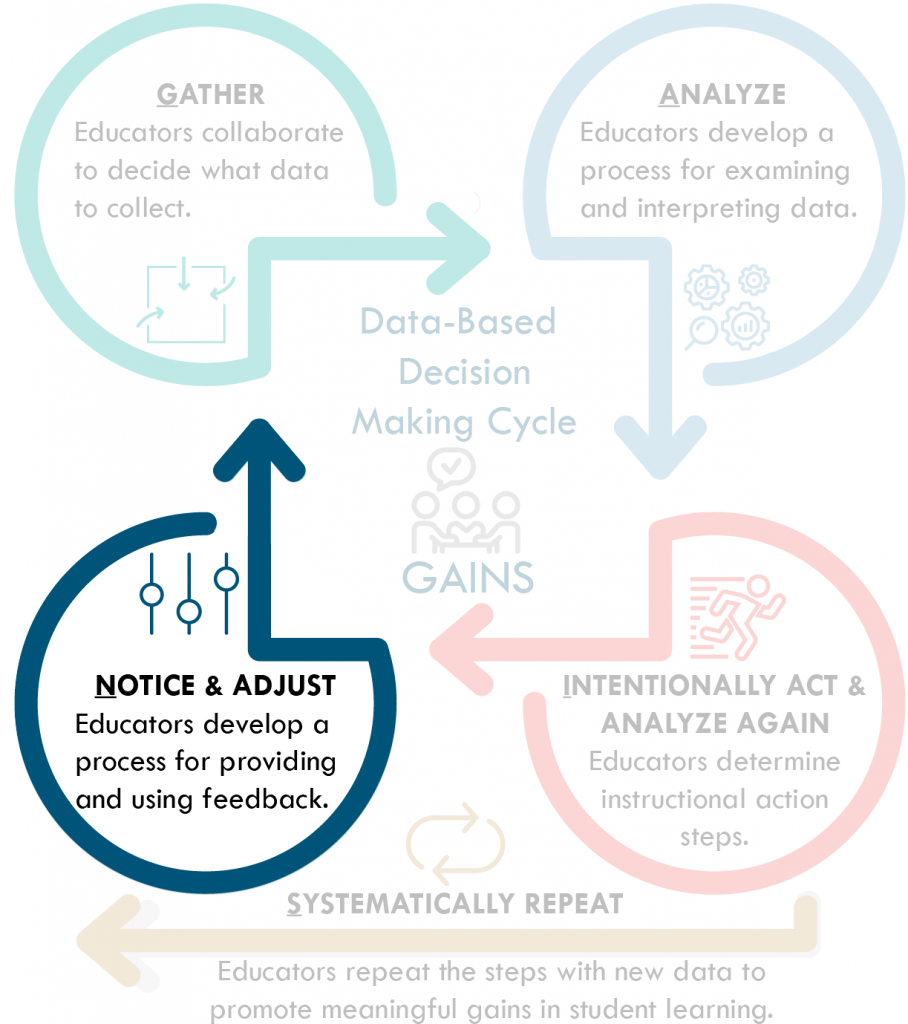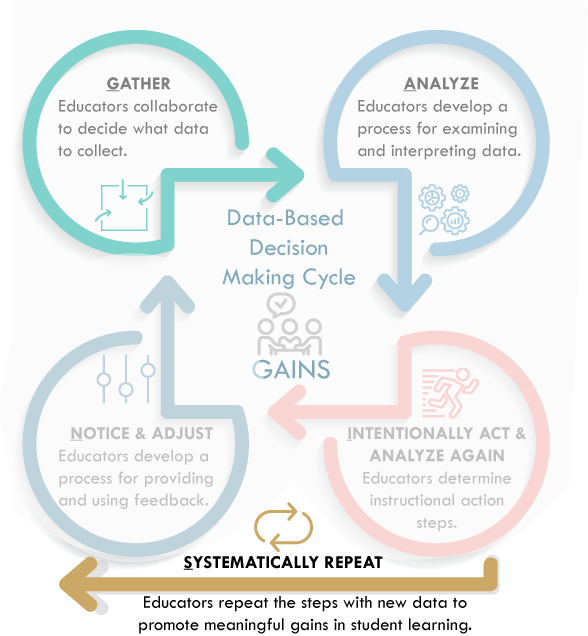Focus on G.A.I.N.S. (icon)
1. Gather data that will identify and prioritize areas needing improvement
Begin with your data. Take a “big picture” look at the variety of data generated across your district to identify and prioritize areas needing improvement. This also includes the data generated from the Mental Models Process tool.
2. Analyze district data to identify problematic areas and to determine practices that strengthen impact on student learning
Analyze district data, including the Mental Models Process information, to identify problematic trends/ behaviors that may be contributing to the problem. Determine specific practices and patterns of behavior to be initiated or strengthened, focusing on those that will have a high impact on student learning.
3. Intentionally Act: Define the change, communicate outcomes, develop & implement an action plan
Step three of the G.A.I.N.S. process is about taking action.
Intentionally act by:
- Clearly outlining what will change and what will remain the same.
- Developing a vision statement that identifies desired outcomes.
- Communicating the purpose behind the change.
- Developing and implementing an action plan that addresses the district’s need(s).
Next, we will expand on step 3 detailing specifics in regard to defining the change, communication, and action planning.
CLEARLY DEFINE THE CHANGE NEEDED AND CREATE AN OUTCOMES-BASED “VISION” STATEMENT
It is important to clearly outline what will change and what will remain the same when designing a plan for district continuous improvement. A vision statement should be developed that identifies desired outcomes. This acts as a compass to guide your plan. Next, draft an outline for the plan, focused on organizational alignment, participation, and shared responsibility.
These seven questions can help provide direction during this part of the process (EOSWorldwide, 2014):
- What are the district’s core values?
- What is the district’s core focus in terms of impact on student learning?
- What is the long-term goal that the district would like the system to accomplish?
- What is the plan for implementation?
- What is the 1-year plan/goal(s)?
- What are the benchmarks that will indicate progress toward the goal(s)?
- What issues might the system face as it moves forward?
COMMUNICATE THE VISION AND PREPARE FOR CHANGE
Communication plays a critical role to ensure staff “buy-in” and that everyone is on the same page. Educators will be the ones implementing changes, therefore it is important to help all stakeholders understand the vision and the importance of their role in implementing the vision. It is also critical for leadership teams to consider how they can prepare staff for the changes that will occur. Educators need to know they will receive needed professional development and that there are structures in place to support the change. Planning for professional development, coaching supports, and needed structures can ensure the process of change goes smoothly.
COMMUNICATION KEY CONSIDERATIONS
A communication plan does not have to be large or formal. However, it is important to plan for effective communication. The purpose of a communication plan is to ensure a consistent message with the necessary information is provided to appropriate groups. It should communicate why the change is important and a timeline for the change. It should also be bi-directional. Reciprocal communication is critical so that those affected by the change have a way to communicate the impact of the change.
Reflect on these questions as you plan for communication:
DEVELOPING AN ACTION PLAN
Outlining an action plan that breaks the implementation process into manageable steps and provides “small wins” can build momentum. Leadership teams also need to consider potential barriers and plan accordingly. For example, what organizational structure(s) might hinder implementation? What resources/tools are needed to implement the plan? Is there a need to restructure job descriptions and update performance review criteria so that they serve your new set of goals?
IMPLEMENTING THE ACTION PLAN
With the change message out in the open, it’s important that staff know they will receive training, structured or informal, to teach the skills and knowledge required to operate efficiently as the change is rolled out.
Identify and remove stumbling blocks.
- A need for additional training or new skills
- An organizational structure that hinders implementation
- A need for new systems and tools to accommodate new methods
- A need to restructure job descriptions and update performance review criteria so that they serve your new set of goals.
Set achievable milestones.
Incorporate the changes in district culture – “the way we do business”.
4. Notice and adjust: Monitor the Effectiveness of the plan and make changes as needed
Once the initial implementation of the plan has begun, leadership teams need methods for monitoring the effectiveness of the plan using key performance indicators. Key performance indicators (KPIs) specify the factors an organization wants to monitor, what will be measured, and how they will be measured.
Key performance indicators (KPIs) are quantifiable measures that can be used to monitor and evaluate success in terms of meeting your district process implementation goals.
KPIs can be used to monitor operational details of the implementation process.
BENEFITS OF USING KEY PERFORMANCE INDICATORS (KPIS)
Effective KPIs are directly related to the action plan’s strategic goals/objectives, identify success criteria, and include data from all levels of the organization (district, building, classroom, etc.). District KPIs may include measures around the adherence to timelines, fidelity of implementation, and/or performance improvement rates. Other metrics may include staff adoption, staff engagement, and proficiency rates along with staff feedback and requests for help or support.
The identification and monitoring of key process drivers can have a major impact on implementation success. Data can provide an “at-a-glance” view of progress and success. Data helps leadership monitor the implementation process and make adjustments quickly. (Key Performance Indicators (KPI) | Examples, Guide And Process Explained, n.d.) /(Change Management KPIs: A Crash Course, 2018)
5. Systematically repeat the process: A cycle of continuous improvement
It is not enough for a leadership team to collect KPI data, they also need to set aside time to analyze the data and plan next steps.
It is essential that student impact measures including data from benchmark assessments, learning growth, attendance, and behavior play a key role.
The G.A.I.N.S. process is not linear, the data collected during and following implementation should cycle the team back to Step 1 to consider needed revisions and additional supports, creating a process for district continuous improvement.
Refection Question
How might your district benefit from utilizing the G.A.I.N.S. process on its path to continuous improvement?


